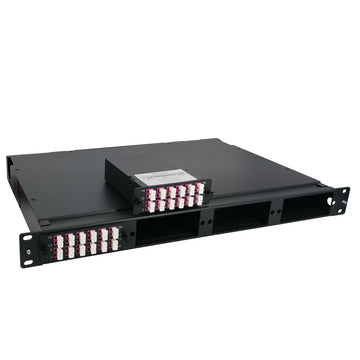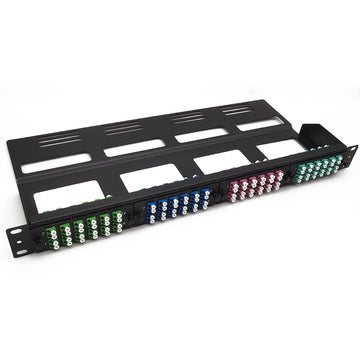How to Identify the Fiber Optic Cable Color Code?
Fiber Optic Cable Outer Jacket Color Code
Fiber cable jacket is made of various types of materials. Colored outer jackets or print may be used on outside plant and premises fiber cables, e.g., fiber distribution cables, fiber optic patch cords, etc. In EIA/TIA-598, the fiber color code defines the jacket color codes for different fiber types. It’s important to consider the jacket type when selecting the compatibility with the application’s connectors and environment. So for optical fiber cable that contains only one type of fiber we can easily identify it by its jacket color; unless otherwise specified, the outer jacket of premises cable containing more than one fiber type shall use a printed legend to identify the quantities and types of fibers within the cable, for example "12 Fiber 8 x 50/125, 4 x 62.5/125."
- Premise cables with multimode fibers are orange (OM1 & OM2 cable), aqua (OM3 cable) and purple (OM4 cable)
- Premise cables with singlemode fibers are yellow.
- Premise cables with mixed (hybrid) fibers are black.
- Indoor/Outdoor cables with any/all fibers are black.
Here are the jacket color codes for different fiber types:
| Fiber Type | Color Code | ||
| Non-military Applications | Military Applications | Suggested Print Nomenclature | |
| OM1 62.5/125µm Multimode | Orange | Slate | 62.5/125 |
| OM2 50/125µm Multimode | Orange | Orange | 50/125 |
| OM3 50/125µm (850 nm Laser-Optimized) Multimode | Aqua | Undefined | 850 LO 50/125 |
| OM4 50/125µm (850 nm Laser-Optimized) Multimode | Aqua/Violet | Undefined | 850 LO 50/125 |
| 100/140µm Multimode | Orange | Green | 100/140 |
| OS1/OS2 Single Mode | Yellow | Yellow | SM/NZDS, SM |
| Polarization Maintaining Single Mode | Blue | Undefined | Undefined |
Notes:
- Natural jackets with colored tracers may be used instead of solid-color jackets.
- Because of the limited number of applications for these fibers, print nomenclature is to be agreed upon between the manufacturer and end-user.
- Other colors may be used provided that the print on the outer jacket identifies fiber classifications.
- For some premises cable functional types (e.g., plenum cables), colored jacket material may not be available. Distinctive jacket colors for other fiber types may be considered for addition to Table 3 at some future date.
Inner Cable Organizational Fiber Color Code.
Inside a multi-fiber cable, individual fibers are compliant to fiber color code as well. They are often distinguished from one another by color-coded jackets, buffers or tubes on each fiber. According to EIA/TIA-598, inner fibers are color coded in a group of 12 fibers and they are counted in a clockwise direction. Up to 24 individual strands can be manufactured loosely, and after that point, they are usually sectioned into tubes containing 12 each. So there are two situations for multi-fiber patch cords:
- For cables that consist of multiple buffer tubes each with 12 or fewer strands. Each tube will be numbered or colored following the same fiber color code.
- For cables that have over 12 strands, the color code repeats itself. Each 12-strand group is identified in some other unique way such as adding a stripe or some other specific marks to the new group.
| Fiber Position | Jacket Color | Fiber Position | Jacket Color |
| 1 | Blue | 13 | Blue with black tracer |
| 2 | Orange | 14 | Orange with black tracer |
| 3 | Green | 15 | Green with black tracer |
| 4 | Brown | 16 | Brown with black tracer |
| 5 | Slate | 17 | Slate with black tracer |
| 6 | White | 18 | White with black tracer |
| 7 | Red | 19 | Red with black tracer |
| 8 | Black | 20 | Black with yellow tracer |
| 9 | Yellow | 21 | Yellow with black tracer |
| 10 | Violet | 22 | Violet with black tracer |
| 11 | Rose(Pink) | 23 | Rose with black tracer |
| 12 | Aqua | 24 | Aqua with black tracer |
Connector Color Code
Connector color code is also a part of the fiber patch cord color code. Inside a multi-fiber cable, individual fibers are compliant to fiber color code as well. They are often distinguished from one another by color-coded jackets, buffers or tubes on each fiber. According to EIA/TIA-598, inner fibers are color coded in a group of 12 fibers and they are counted in a clockwise direction.
| Fiber Types | Polish Style | Connector Body | Strain Relief/Mating Adapter |
| OM1 62.5/125 | UPC | Beige/Grey | Beige/Grey |
| OM2 50/125 | UPC | Black | Black |
| OM3/OM4 50/125 laser optimized | UPC | Aqua | Aqua |
| Single Mode | UPC | Blue | Blue |
| Single Mode | APC | Green | Green |
However, with the advent of metallic connectors like the FC and ST, connector color coding becomes difficult. Therefore, colored strain relief boots or shells are also used. The boot color may vary among manufacturers.
One thing to remember on color coding—it’s an industry standard, TIA 598—which means it’s voluntary. Don’t be surprised if you find black, pink, olive or any other color cables. The customer can specify any colors they want. Now the cables with connectors in the photo above become more obvious. The aqua connector and aqua cable tell us that cable is 50/125 OM3 or OM4, and for a short patchcord, there is no real difference in the two. The beige connector on an orange cable says it is 62.5/125 fiber and the yellow cable with blue connector means that patchcord is single-mode fiber with a regular PC connector.
Conclusion
Fiber optic cable color code is a system that helps us distinguish fiber types visually from the colored fiber jacket, fiber connector, fiber boot, etc. Thus, fiber cable color coding is essential to fiber optic communications like the twisted pair color coding to copper wiring systems. LightOptics offers a broad range of standard fiber optic cable types. If you want to know more about fiber cable cord, kindly contact sales@lightoptics.co.uk for more details.












